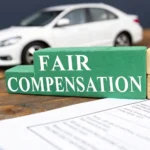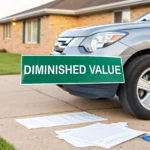A car accident diminished value claim helps you recover the drop in your vehicle’s resale price after it’s been wrecked and repaired. Even with perfect repairs, an accident history sticks to your car’s record, making it worth less to a potential buyer than an identical car with a clean past. Understanding your right to this compensation is the first step toward getting the money you’re rightfully owed.
What Exactly Is Diminished Value?

Let’s paint a picture. Imagine two identical used cars on a lot—same make, model, year, and mileage. One has a spotless vehicle history report. The other has a major collision on its record, even though it was repaired by top-notch technicians.
Which one would you buy? And which one would you expect a steep discount on?
Most people would choose the one with no accident history or demand a significant price cut on the one that was damaged. That price cut is the car’s diminished value. It’s a real, tangible financial loss that the repair bill from the body shop doesn’t cover.
Diminished Value at a Glance
| Concept | Simple Explanation |
|---|---|
| Inherent Diminished Value | The automatic loss in value simply because the vehicle now has an accident history. |
| Repair-Related DV | Additional value lost due to poor-quality repairs or non-original parts. |
| Market Perception | The “stigma” that makes buyers wary of previously damaged vehicles, driving the price down. |
| Vehicle History Report | A permanent record (like CarFax) that alerts potential buyers to the accident. |
Ultimately, a wrecked-and-repaired car is simply not as desirable as one that has never been damaged, and the market reflects that.
The Stigma of an Accident Record
The real problem is market perception. Today, anyone buying a used car—from a private seller to a professional dealership—pulls a vehicle history report from services like CarFaxor AutoCheck. An accident on that report is a massive red flag. It immediately creates doubt about the car’s long-term reliability and structural integrity.
This stigma isn’t just a feeling; it has a powerful effect on what people are willing to pay. Market data consistently shows that a vehicle’s resale value can plummet after a collision, regardless of how great the repairs look.
Proving Your Loss Is Key
Because this loss is tied to market perception, the at-fault driver’s insurance company will often try to ignore it. They might argue that high-quality repairs made your car “whole” again, but that logic overlooks a critical truth: the market disagrees.
To successfully recover your car accident diminished value, you have to provide proof of two things:
- The fair market value of your vehicle before the accident.
- The fair market value after repairs, showing the drop caused by the new accident history.
This is where a professional, independent appraisal becomes essential. It provides the unbiased, data-backed evidence needed to counter the insurer’s lowball tactics and support your negotiations for fair compensation. You can learn more by reading our complete guide on what vehicle diminished value is.
Understanding the Three Kinds of Diminished Value
When you hear “diminished value,” it’s easy to think of it as one single concept. In reality, this loss breaks down into three distinct categories. Figuring out which type applies to your situation is the first step in building a strong claim.
Inherent Diminished Value
This is the most common and unavoidable type of loss. Inherent Diminished Value is the automatic drop in your car’s market price simply because it now has an accident on its permanent record. Even with flawless repairs that make the car look and drive like new, that collision history creates a permanent stigma.
A vehicle history report showing a collision is a huge red flag for savvy buyers. They will almost always pay less for a car with a documented accident, no matter how great the repairs are. This creates an immediate and permanent loss of value.
For example, take a pristine sedan worth $25,000. After being rear-ended and perfectly repaired, its vehicle history report now shows a moderate collision. When a buyer compares it to an identical car with a clean record, which one will they choose? To sell the repaired car, the owner will have to offer a discount. That discount is its inherent diminished value.
Repair-Related Diminished Value
While inherent diminished value occurs even with perfect repairs, Repair-Related Diminished Value happens when the repairs are less than perfect. This is a direct hit to your car’s value caused by shoddy workmanship or cheap, non-original parts.
Common signs of repair-related issues include:
- Mismatched Paint: The new paint job doesn’t quite blend with the original factory finish.
- Uneven Panel Gaps: The doors, hood, or trunk don’t line up correctly.
- Use of Aftermarket Parts: The shop used non-OEM (Original Equipment Manufacturer) parts, which can affect performance, safety, and appearance.
- Unresolved Mechanical Issues: The car doesn’t drive the same—maybe there’s a new rattle or a slight pull to one side.
This type of value loss is in addition to the inherent loss. It’s an extra penalty because the car wasn’t restored to its best possible post-accident condition.
Immediate Diminished Value
This type is less common for the average claim but is still important. Immediate Diminished Value is the difference in your car’s value right after the accident, before any repairs have been made. It’s the value of your car in its wrecked, damaged state.
This concept mainly comes into play if you consider selling the damaged car as-is or if there’s a dispute with the insurer before repairs begin. For most owners, the main battle will be proving the inherent diminished value. You can explore our guide to learn more about how much an accident can devalue your car.
Why Insurers Often Undervalue Your Claim

After a car accident that wasn’t your fault, you expect the at-fault driver’s insurance company to make things right. However, many car owners are shocked when they receive a lowball offer for their car accident diminished value.
Insurance companies are for-profit businesses, and their goal is to minimize claim payouts. Their adjusters are trained with specific tactics designed to protect their bottom line, not yours. Knowing their playbook is the first step to fighting back for the full compensation you deserve.
Common Tactics Used by Insurance Adjusters
Insurance adjusters use a handful of strategies to deny or devalue diminished value claims. They count on you being unfamiliar with the process and hope you’ll accept their first offer.
Watch out for these common moves:
- The Lowball Offer: They almost always start with an offer that’s a fraction of your vehicle’s true loss in value.
- Denying the Concept: Some adjusters may try to tell you that diminished value isn’t a “real” loss or isn’t covered. This is not true in most states for third-party claims.
- Claiming “Perfect” Repairs: A favorite argument is that professional repairs restored your car to its “pre-loss condition.” This ignores the permanent stain an accident leaves on your vehicle’s history report.
Insurers know a vehicle’s accident history is a permanent red flag that hurts its resale value. But their arguments conveniently focus only on physical repairs, sidestepping the real financial hit you’ll take when you sell or trade in your car.
The Problem with the 17c Formula
One of the most common tools insurers use to justify a lowball number is a calculation called the “17c formula.” This formula, which originated from a Georgia court case, is often used by insurance companies because it applies a series of caps and modifiers that almost always produce a diminished value figure far below your actual market loss.
Here’s how it works against you:
- Damage Modifier: It applies a subjective reduction based on the severity of the damage (e.g., minor, moderate, or severe).
- Mileage Modifier: It then cuts the value again based on your car’s mileage.
This method is stacked in the insurer’s favor and has little to do with how real buyers think. Because many major carriers use this formula, having a rock-solid, independent appraisal is non-negotiable. Our guide on filing a State Farm diminished value claim goes into more detail on how to counter these arguments.
To win a negotiation, you need proof. A certified appraisal from SnapClaim provides the objective data and market analysis needed to challenge flawed formulas and prove your vehicle’s real loss in value.
How to Accurately Calculate Your Vehicle’s Loss in Value

Figuring out the true financial hit from a car accident diminished value claim isn’t about guesswork. You can’t just accept the insurance company’s lowball offer. The real value is determined by the open market—what a real person would pay for your car now.
While insurers love their biased formulas, an accurate calculation demands an objective look at real-world data. It all comes down to establishing what an informed buyer would pay for your car now that it has a permanent accident history.
Key Factors in a Diminished Value Calculation
A credible appraisal doesn’t just pull a number out of thin air. It’s a detailed analysis based on specific factors that impact the used car market.
A professional appraiser will meticulously look at:
- Vehicle Specifics: The make, model, year, and trim. Luxury cars and newer models often take a bigger percentage hit to their value.
- Pre-Accident Condition: The car’s overall shape, mileage, and maintenance history before the collision.
- Severity of Damage: Structural or frame damage will cause a much greater loss in value than cosmetic dings.
- Quality of Repairs: Were high-quality, OEM parts used? An expert can spot shoddy work, which drags the value down further.
These pieces come together to paint a clear, evidence-based picture of your financial loss. You can get a quick snapshot of your potential claim with a free online tool, like SnapClaim’s diminished value claim calculator, to see a starting estimate.
Why Vehicle History Reports Are Crucial
The rise of digital vehicle history reports has completely changed the game. Today, services like CarFax and AutoCheck make a car’s entire accident history available to any potential buyer in seconds. This means even a minor, perfectly repaired collision can cause a significant drop in value, as the documented accident creates doubt for buyers.
The Gold Standard: An Independent Appraisal
While online estimators are a good first step, the ultimate proof you need is a certified, independent appraisal. This isn’t just an opinion—it’s a court-ready document that provides the hard evidence needed to back up your claim and counter the insurance adjuster’s arguments.
An independent appraisal report from a trusted source like SnapClaim is your most powerful tool. It replaces the insurer’s biased formula with an objective, market-based valuation, giving you the leverage to demand fair compensation.
When you present the adjuster with a detailed, professional report, the entire conversation changes. You’re no longer just asking for more money; you’re proving your financial loss with documented evidence.
And with SnapClaim’s money-back guarantee—if the insurance recovery from the claim is less than $1,000, your appraisal fee is fully refunded—there’s absolutely no risk in getting the proof you need.
Your Step-by-Step Guide to a Successful Claim
Filing a car accident diminished value claim can feel intimidating, but it’s a straightforward process when you break it down. With the right paperwork and a logical approach, you can confidently pursue the money you’re owed from the at-fault driver’s insurance company.
Step 1: Confirm You Are Not at Fault
First things first—you must be sure you weren’t the one who caused the accident. Diminished value claims are almost always filed against the at-fault driver’s insurance policy, known as a third-party claim. If you were responsible for the crash, your own policy typically won’t cover this type of loss.
Step 2: Gather All Essential Documents
Your claim is only as strong as your evidence. Start by collecting every piece of paper related to the accident and repairs.
This documentation should include:
- The Official Police Report: This establishes the facts of the accident, including who was determined to be at fault.
- Repair Invoices and Estimates: The final, itemized repair bill from the body shop shows the extent of the damage and what it cost to fix.
- Photos and Videos: Collect any pictures you took of the damage immediately after the accident and after the repairs were completed.
Step 3: Obtain a Certified Diminished Value Appraisal
This is the most critical step. An independent, certified appraisal is the heart of your claim—it’s the unbiased, expert proof of your financial loss. While the police report proves fault and repair bills show the damage, the appraisal report puts a hard number on the loss in your car’s market value.
A professional report from SnapClaim elevates your claim from a simple request to a formal demand backed by real-world market data. It provides the proof you need to challenge the insurer’s lowball offer.
Step 4: Submit a Formal Demand Letter
Once you have your appraisal report and supporting documents, you’re ready to file your claim. Send a demand letter to the at-fault driver’s insurance adjuster. Keep the letter professional and to the point, clearly stating the amount you’re claiming based on your appraisal and attaching copies of all your evidence.
Step 5: Negotiate with Confidence
Don’t be surprised when the adjuster comes back with a lower offer—it’s part of their playbook. This is where your appraisal report becomes your most powerful tool. Stay calm and refer back to the market data and expert valuation in your report to counter their arguments.
This visual guide breaks down the core workflow for a winning claim.

This process shows how a solid appraisal gives you the foundation you need to submit a strong claim and negotiate a fair settlement.
For tough cases where an insurer won’t negotiate fairly, you might consider speaking with an attorney. You can find more information in our guide on diminished value claims and attorneys.
And remember, SnapClaim’s money-back guarantee makes this process risk-free. If the insurance recovery from your claim is less than $1,000, we’ll refund your appraisal fee in full.
FAQ: Common Questions About Car Accident Diminished Value
Here are answers to a few common questions vehicle owners have about diminished value claims.
Can I file for diminished value if I caused the accident?
In nearly all cases, the answer is no. Diminished value is claimed from the at-fault driver’s insurance policy (a “third-party claim”). Your own insurance policy is designed to cover your repair costs, not the drop in your car’s resale value. The main exception is for residents of Georgia, where state law may allow you to file a diminished value claim through your own policy.
How long do I have to file my claim?
Yes, there is a deadline. Your claim falls under your state’s statute of limitations for property damage. This legal window is typically between two to six years from the date of the accident. It’s critical to know the time limit in your state and act before it’s too late. You can often find this information on your local Department of Motor Vehicles (DMV) website.
Will this claim make my own insurance rates go up?
Filing a diminished value claim against the other driver’s insurance should not affect your own insurance premiums. Your rates typically only go up when you cause an accident and your own policy has to pay out. Since another driver was at fault and their insurance is responsible for the loss, there’s no legitimate reason for your insurer to raise your rates.
What if the insurer ignores my certified appraisal?
Don’t panic if an adjuster initially dismisses your appraisal—it’s a common negotiation tactic. A professional, data-backed appraisal is your most powerful piece of evidence. If an adjuster rejects it, calmly ask for a detailed, written justification for their valuation. A credible report from SnapClaim is designed to withstand scrutiny and shows you are prepared to negotiate with proof, which helps strengthen your claim for a fair settlement.
Don’t let the insurance company dictate what your car is worth. A SnapClaim report provides the proof needed to negotiate fair compensation. Our process is fast, affordable, and backed by a money-back guarantee, so there is no risk in getting the evidence you need.
About SnapClaim
SnapClaim is a premier provider of expert diminished value and total loss appraisals. Our mission is to equip vehicle owners with clear, data-driven evidence to recover the full financial loss after an accident. Using advanced market analysis and industry expertise, we deliver accurate, defensible reports that help you negotiate confidently with insurance companies.
With a strong commitment to transparency and customer success, SnapClaim streamlines the claim process so you receive the compensation you rightfully deserve. Thousands of reports have been delivered to vehicle owners and law firms nationwide, with an average of $6,000+ in additional recovery per claim.
Why Trust This Guide
This article was reviewed by SnapClaim’s team of certified auto appraisers and claim specialists with years of experience preparing court-ready reports for attorneys and accident victims. Our content is regularly updated to reflect the latest industry practices and insurer guidelines.
Get Started Today
Ready to prove your claim? Generate a free diminished value estimate in minutes and see how much you may be owed.
Get your free estimate today





